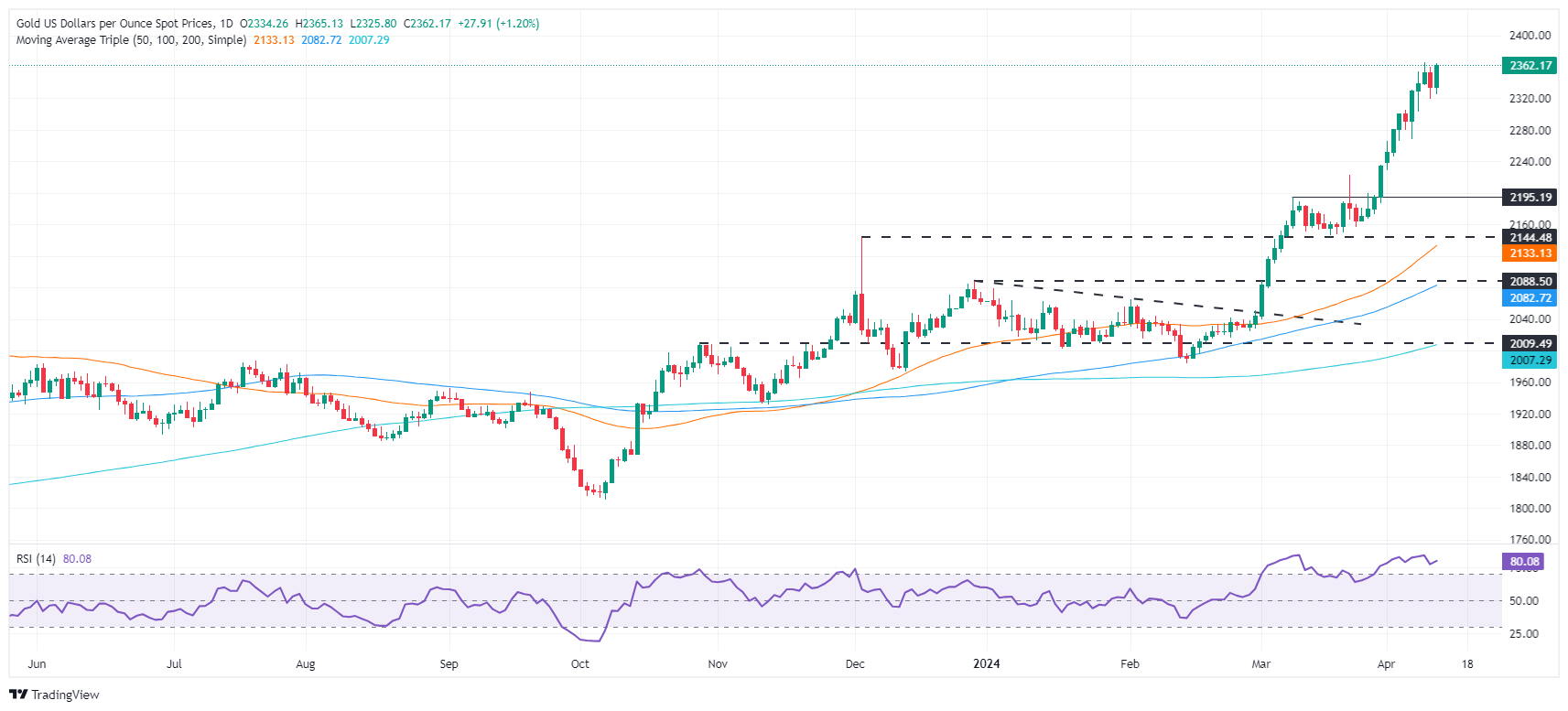- Gold prices recover, buoyed by falling US Treasury yields and a weaker US Dollar.
- Mixed signals from producer inflation, labor data bolster Gold amid uncertainties.
- Fed officials’ inflation worries enhance Gold’s safe-haven appeal, swaying sentiment.
Gold price erased Wednesday’s losses and climbed past the $2,360 area on Thursday, shrugging off a red-hot consumer inflation report. Further data was revealed earlier during the North American session with the Producer Price Index (PPI) showing signs of easing inflation. Consequently, US Treasury yields fell, capping the US Dollar rally.
XAU/USD spot trades at new all-time highs at around $2,374 a troy ounce, posting solid gains of 1.70%. The US Bureau of Labor Statistics (BLS) revealed additional inflation data on the producer side, alongside Initial Jobless Claims. The number of Americans filing for unemployment benefits was below the previous reading and forecasts, indicating the labor market remains tight.
Federal Reserve (Fed) officials grabbed some highlights. New York Fed President John Williams and Richmond Fed President Thomas Barkin added that recent inflation data was disappointing and doesn’t increase confidence that disinflation is spreading.
Daily digest market movers: Gold shrugs off hot US CPI report, resumes uptrend
- The March US Producer Price Index (PPI) showed that the disinflation process continues, with data clocking at 0.2% MoM, below estimates of 0.3%. The core PPI printed at 0.2% MoM, which is below estimates and February’s reading.
- In the twelve months to March, the PPI rose by 2.1%, less than projections but surpassing February’s 1.6%. The core PPI stood at 2.4%, however, above estimates and the previous month’s data.
- Initial Jobless Claims for the week ending April 6 dipped from 222K to 211K, below estimates of 215K, reinforcing the labor market’s robustness following last Friday’s release of the Nonfarm Payrolls report.
- High inflationary levels in the United States, revealed by the March Consumer Price Index (CPI) report, prompted investors to trim expectations of the Fed’s rate cuts.
- Data from the Chicago Board of Trade (CBOT) suggests that futures traders expect just two cuts to the fed funds rate as they project the main reference rate to end the year at 4.955%.
- Despite that, the fall of US Treasury nominal and real yields is a headwind for Gold prices. US real yields fall three basis points to 2.148%.
- The US Dollar Index (DXY) also witnessed a substantial increase, soaring over 1% to reach new YTD high of 105.27.
- World Gold Consortium reveals that the People’s Bank of China was the largest buyer of the yellow metal in February, increasing its reserves by 12 tonnes to 2,257 tonnes.
Technical analysis: Gold’s rise resumes as buyers eye $2,400

Gold remains upwardly biased despite dipping toward the $2,310 area on Wednesday. Nevertheless, the drop in US real yields sponsored XAU/USD’s last leg up, with buyers threatening to push prices to refresh all-time highs.
If XAU/USD decisively surpasses the $2,365 area, it would pave the way to challenging the psychological $2,400 mark. Further upside is seen at $2,450 and $2,500.
On the other hand, if the precious metal’s price drops below $2,359, look for a challenge of the April 10 low of $2,319, followed by the April 8 daily low of $2,303. Once cleared, the next support would be March’s 21-session high of $2,222. Further losses are seen at $2,200.
Inflation FAQs
Inflation measures the rise in the price of a representative basket of goods and services. Headline inflation is usually expressed as a percentage change on a month-on-month (MoM) and year-on-year (YoY) basis. Core inflation excludes more volatile elements such as food and fuel which can fluctuate because of geopolitical and seasonal factors. Core inflation is the figure economists focus on and is the level targeted by central banks, which are mandated to keep inflation at a manageable level, usually around 2%.
The Consumer Price Index (CPI) measures the change in prices of a basket of goods and services over a period of time. It is usually expressed as a percentage change on a month-on-month (MoM) and year-on-year (YoY) basis. Core CPI is the figure targeted by central banks as it excludes volatile food and fuel inputs. When Core CPI rises above 2% it usually results in higher interest rates and vice versa when it falls below 2%. Since higher interest rates are positive for a currency, higher inflation usually results in a stronger currency. The opposite is true when inflation falls.
Although it may seem counter-intuitive, high inflation in a country pushes up the value of its currency and vice versa for lower inflation. This is because the central bank will normally raise interest rates to combat the higher inflation, which attract more global capital inflows from investors looking for a lucrative place to park their money.
Formerly, Gold was the asset investors turned to in times of high inflation because it preserved its value, and whilst investors will often still buy Gold for its safe-haven properties in times of extreme market turmoil, this is not the case most of the time. This is because when inflation is high, central banks will put up interest rates to combat it. Higher interest rates are negative for Gold because they increase the opportunity-cost of holding Gold vis-a-vis an interest-bearing asset or placing the money in a cash deposit account. On the flipside, lower inflation tends to be positive for Gold as it brings interest rates down, making the bright metal a more viable investment alternative.

























